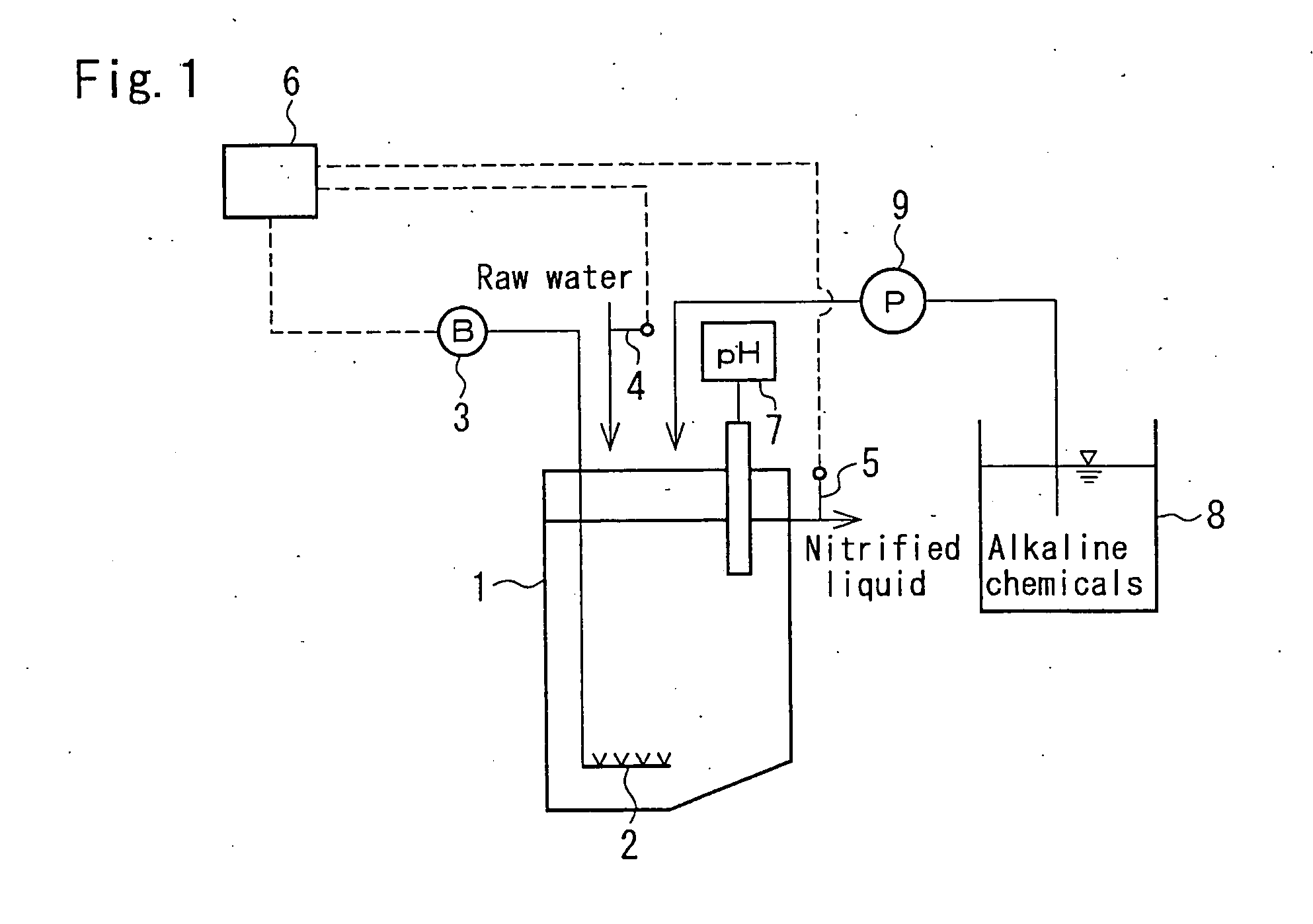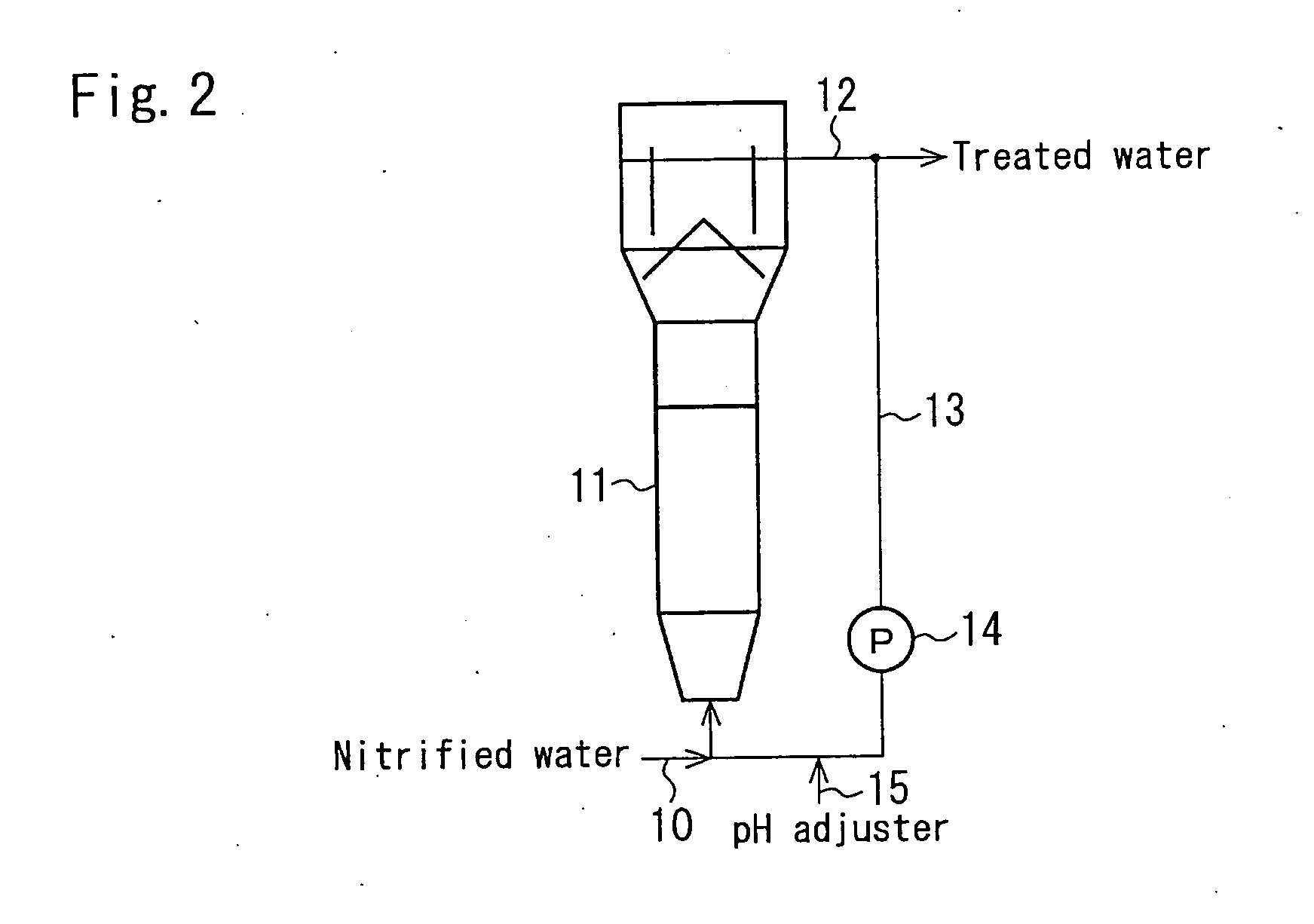Nitrifying method and treating method of water containing ammonium-nitrogen
a technology of ammonium nitrogen and nitrification method, which is applied in the direction of biological water/sewage treatment, sustainable biological treatment, multi-stage water/sewage treatment, etc., can solve the problems of sensor difficulty in accurate continuous measurement, high running cost of conventional nitrification-denitrification method, and inability to meet the needs of water quality, etc., to achieve high efficiency
- Summary
- Abstract
- Description
- Claims
- Application Information
AI Technical Summary
Benefits of technology
Problems solved by technology
Method used
Image
Examples
example 1
[0056] In FIG. 1, a sponge carrier of 90 L was placed in a nitrification reactor 1 of 300 L in volume. Activated sludge derived from sewage sludge was fed to the nitrification reactor 1 and digestive liquor of an anaerobic nitrification reactor (pH 7.5, NH4—N concentration approx. 400-500 mg-N / L) was supplied as raw water to the nitrification reactor 1 at a rate of 2 m3 / d. Hydraulic retention time (HRT) in the reactor was approx. 3.6 hours. As measuring apparatuses 4, 5 for the NH4—N concentration, diaphragm ion electrodes were used.
[0057] The ammonium concentration of the raw water and the ammonium concentration of the nitrified liquid were measured, and the target NH4—N concentration of the nitrified liquid was set from the NH4—N concentration of the raw water, and the flow volume for aeration by the blower 3 was controlled such that the detected actual NH4—N concentration of the nitrified liquid became the target NH4—N concentration. Flow volume for aeration varied in the range ...
example 2
[0059] Nitrified liquid from the nitrification reactor 1 of Example 1 was fed to the denitrification reactor 11 shown in FIG. 2 and underwent denitrification treatment. The volume of the reactor 11 was 300 L and was filled with 180 L of granule of ANAMMOX bacteria. Hydrochloric acid solution (10% concentration) was added by adding means 15 such that the pH of the reactor 11 became 7.3.
[0060] Influent quantity of the nitrified liquid was set to 2 m3 / d, and the HRT of the reactor 11 was set to approx. 3.6 hours.
[0061] The changes with time in NH4—N concentration, NO2—N concentration, and NO3—N concentration of the denitrified water are shown in FIG. 4.
[0062] As shown in FIG. 4, the NH4—N concentration, the NO2—N concentration, and the NO3—N concentration of the denitrified water were extremely low.
PUM
| Property | Measurement | Unit |
|---|---|---|
| temperature | aaaaa | aaaaa |
| temperature | aaaaa | aaaaa |
| concentration | aaaaa | aaaaa |
Abstract
Description
Claims
Application Information
 Login to View More
Login to View More - R&D
- Intellectual Property
- Life Sciences
- Materials
- Tech Scout
- Unparalleled Data Quality
- Higher Quality Content
- 60% Fewer Hallucinations
Browse by: Latest US Patents, China's latest patents, Technical Efficacy Thesaurus, Application Domain, Technology Topic, Popular Technical Reports.
© 2025 PatSnap. All rights reserved.Legal|Privacy policy|Modern Slavery Act Transparency Statement|Sitemap|About US| Contact US: help@patsnap.com



